Taking Your Business Online: Digitization During Coronavirus Quarantine
READ WHOLE ARTICLE
Does the global pandemic make your sales decrease and customer-base shrink? Don’t be discouraged! Existing and potential buyers haven’t just up and disappeared. They’re just looking for efficient contactless ways of shopping. The social distancing rules boost the common tendency to shop online more than ever.
There is no time to wait until the COVID-19 pandemic wears off. Your best bet is to supply your business with a commercial online platform. You can take your offline business online to get profits in the harshest global conditions. The virus will recede sooner or later while your eCommerce remains a valuable sales tool.
Advantages of Online Business vs Offline Business
If we compare online and offline business practices, especially in the current pandemic conditions, eCommerce boasts several benefits:
- No social distancing issues whatsoever so you can retain customers;
- Service availability 24/7;
- Cost-efficient management;
- No physical premises taxes;
- Non-stop performance (before, during, and after full migration).
A Comprehensive Guide to Choose eCommerce Platform
E-commerce platforms provide great business opportunities. For instance, Shopify is an extensive online business system preferred today by more than 325,000 online stores all over the world. It is the pioneer of many features that have become the eCommerce staple for both buyers and service providers.
Namely, the Shopify platform offers:
- accessibility of use and powerful integrations;
- extensive customization opportunities;
- numerous SEO features (meta content, ALT tags, etc.);
- a huge selection of plugins and integrations, including great themes and design assets;
- best tech support in the niche.
Shopify offers a number of strategies for supporting small businesses. For example, digital and regular gift cards are available with all Shopify plans.
If you are based in the US, you can count on a fraction of the $200M Shopify Capital.
The platform contributes to communities and live webinars: you can ask for help from numerous members of the Shopify community. Monthly fees are low, although as your business grows, the underlying costs may grow respectively. But even this isn’t a sufficient reason to refuse a tool of this level!
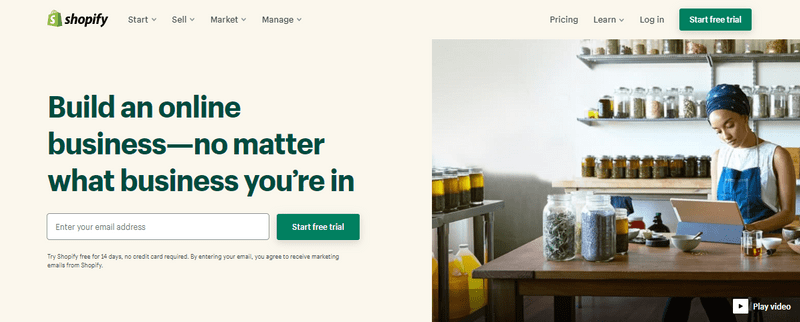
How to Launch an Online Store
The creation of an eCommerce solution implies several major steps to take. First things first, you need to get a domain name.
Buy a domain name
Users access the online store by its address (domain). Ideally, the domain name should be the same as the company name. For $15-20, you can register a domain for a year. All in all, try to pick something that is:
- easily perceptible both visually and when spoken;
- not too long;
- simply transliterated;
- composed of relevant keywords.
Start by looking for a domain provider platform that offers a wide variety of standard, premium, and national domain extensions. If the preferred “.com” version is not available, the “.net” or “.co” extension can be registered.
Extensions such as .ca and .uk may work well for local businesses. Trademarked domains can cause legal problems and should be avoided. If you need to create a unique identity, use the Oberlo Business Name Generator.
How to Choose and Set Up Web Hosting
Create a website
Settling the basic type of your future platform is a crucial step of the way. If you provide design services, you can create a blog with practical advice. This will help build your reputation and enable the ability to make online bookings.
If you’re all about retail, you must register on the eCommerce platform. Shopify is easy to use and set up. Create an account, build a Shopify website with no necessary coding knowledge, and start making money off of it right away.
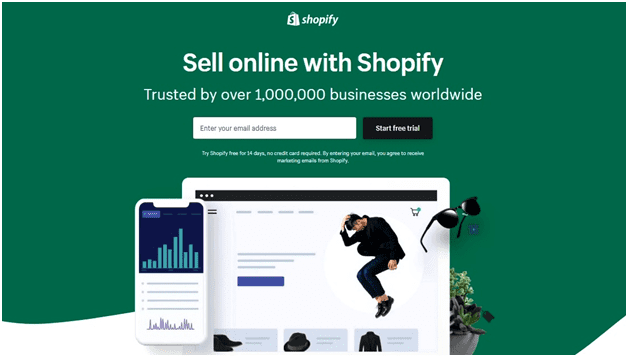
Work on the site’s design
The website design should not only reflect the personality of the brand but also allow customers to easily navigate. Shopify allows sellers to build an easily recognizable image. The platform offers a number of themes (templates) also allowing to:
- Use a unique logo;
- Customize backgrounds, font types, and navigation elements;
- Add and edit content page by page;
- Add social media links to footers;
- Display email subscription forms;
- Use videos, images, and other dynamic elements.
Combine the default capabilities with custom design assets to take your commercial resource to the next level.
Add content to your website
Launching an online store, one should know precisely what type of products will be distributed. While service companies don't have to worry about storage and shipping, retail businesses may need to cut inventory to keep costs down.
When choosing products to sell, start by adding the top sellers to your site. Think about which things the buyer is most interested in. If you can’t afford sufficient storage, a dropshipping tool such as Oberlo can be used. Dropshipping will give you the opportunity to sell as many products as you need not bothering with any storage costs whatsoever.
Content is critical to promoting an online business. Since a shopper cannot visit a store in person, the only way to create an image of the business is to compose good content. To let people know your story, as well as get to know your products or services, add descriptions to the key pages of the site, like so:
- Homepage - a brief description of what the company does: some quality visuals that showcase your product or service. Optionally, reviews from existing customers.
- About us - an authentic story with lifestyle image display showing real people behind the company.
- Products or Services - more detailed information. Break features and benefits you offer into short, digestible parts. Use subheadings, bullet lists, and visuals to improve layout and readability.
- Returns and Refunds - this page shows the attitude towards the buyer. Use colloquial language, list the exact return conditions, and to which products they apply. Place the link to this page in a prominent place.
- Feedback - include your business email address, phone number, physical address, opening hours, and social media information. Shopify offers various templates for contact forms, too.
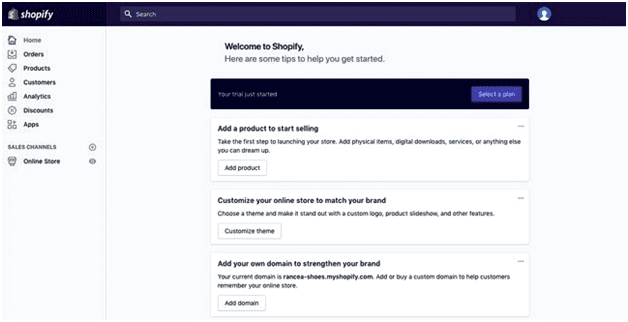
Set up your payments
A method for accepting payments is a crucial part of any retail. Moving your business online, it’s best to monetize income via several payment gateways to stay versatile and let customers choose what they prefer. Shopify offers an integrated payment solution - Shopify Payments. A user can subscribe to it by providing your bank account number, product information, and personal details.
Once activated, you can accept a variety of payment options, including Apple Pay and Google Pay. Shopify Lite comes with a standard merchant feature that accepts payments by credit card, PayPal, Square, or Stripe. Shopify's unique POS system enables offline sales, and the integration with Amazon and eBay offers tremendous opportunities.
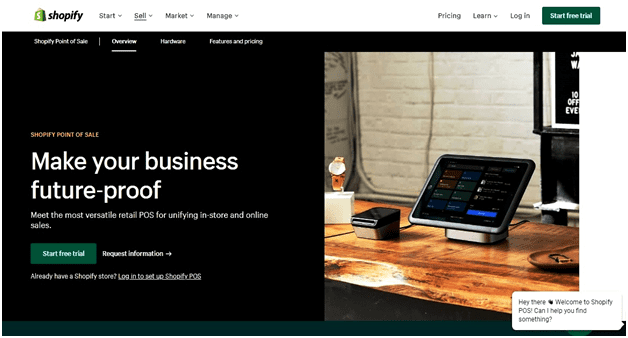
Develop your marketing strategy
Next up - work on a marketing plan. Use multiple tactics to attract and retain customers. This will help you make decisions about which customers to reach primarily and how to communicate information to them. Understanding the strategic objectives will make it easier to choose the best marketing tactics for different sales stages.
TOP 10 Ways to Promote Your Shopify Store
Create social pages
Integration with social networks greatly boosts sales. The Sell on Facebook option allows you to seamlessly sell products around the world. Shopify can be merged with your existing Facebook Business account. The system creates a Store tab for your social media campaign that includes product galleries and a secure shopping cart. The whole solution is also optimized for mobile devices.
You don't have to bother with updating prices, availability, descriptions, and product images in social media manually. When a change is made in Shopify, all changes are synced to your Facebook account.
The slightly less expensive version of Shopify Lite provides a live chat module for the Facebook messenger. This optional feature offers a great way to connect with customers. Built-in automatic replies allow shoppers to instantly get answers to common questions.
Each response contains a call to action at the end. Facebook Messenger also ensures that the customer is aware of the shifting goods after the purchase through automatic messages with information about the delivery progress.
Promote your solution
It's important to be clear about how to build an online business, but it's much more important to get people to notice your offer on the Internet. One of the biggest challenges is standing out from the crowd of competitors. Do your best to share your offers and mark differences between yours and others. This is possible through the following channels:
- Email - never take the path of least resistance and spam, instead, gather a mailing list of customers, create an email newsletter, update it and send it to everybody on the list regularly.
- Social media - create posts on Facebook, Instagram, Pinterest, LinkedIn, and other social platforms where you prefer to manage a business profile. Always add a link to your store. Instagram stories, for instance, can be a great customer-driving tool.
- Search engines - once your commercial resource is launched in the web, focus on SEO practices to promote it in search systems (use keywords, Google Ads, and provide unique, relevant descriptions).
- Influencers - ask users that are related to your niche and have lots of followers or fans to promote your goods. Offer partnership deals. You can post interviews with experts or reviews about particular products or ask influencers to do that on their side.
As soon as you promote well and get enough orders to compensate the underlying expenses - most of the hardest are out of the way. From there on out, you should focus on further growth and development. This is where you should track and analyze every fluctuating factor (traffic, rates of income, closed deals, user reach, etc.)
Improving Your Business During the COVID-19 Quarantine
Nobody knows how long the pandemic will last, but we are confident that online sales will only grow further. Now is the perfect time to grow your online presence for both startups and large businesses.
Consumer demand is stronger than ever, so it’s a good time for the business to be positioned on the web to maintain existing and establish new relationships with customers. This is a great opportunity to expand your customer base without limit and boost your business metrics.
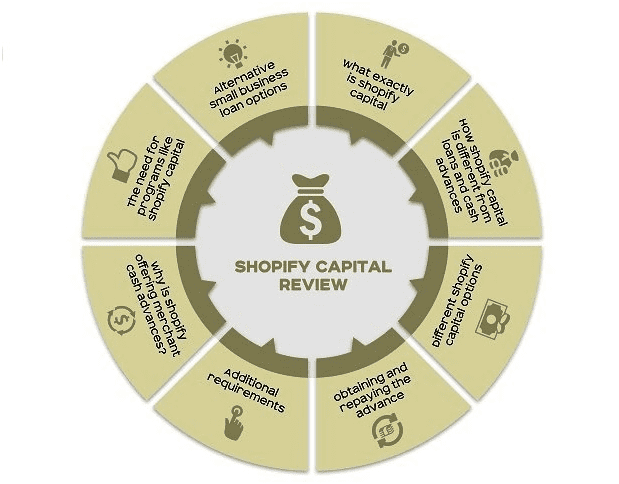
Expand your target market by adding new popular items
During a coronavirus outbreak, many customers simply can’t use products and services physically. People find different ways to cope with the situation. For instance, cleaning companies began to offer services for sterilization and disinfection of building entrances and non-residential premises. The demand is not that high, but it allows people to keep working. Distilleries switched to the production of disinfectants. Some give them away for free, which serves as a great marketing strategy for increasing customer loyalty.
If you're not starting from scratch and already have an established business, add products to your store that are sure to be in demand. Try shelf-stable products, medical masks, antiseptics, gloves and detergents, and other crisis-relevant commodities.
On top of that, you can adjust the store's supply to match the demand. If you sell groceries, add readymade meals or grocery baskets to the assortment, offer delivery at a convenient time for the buyer.
Introduce new ways to deliver your products
Now that avoiding all possible contact has become a common lifestyle, delivery methods must be adjusted as well. Offer pickup and/or contactless delivery.
For example, a client comes to pick up the product and reports it by phone. You put the order in the trunk of a client's car, which is open from the inside, or leave it at the door, while the client walks away a couple of meters. Everything happens without any direct contact involved. You can inform that the order has been delivered via a message or a call. Many restaurants and bars currently offer online orders and roadside deliveries.
People love going through stores just to find out prices. You need to figure out how to let them do it virtually. You can offer personalized recommendations that the customer can rely on. Taking virtual walks around the store via FaceTime, can help customers choose products more conveniently. Service-oriented companies, like fitness studios, can conduct virtual classes while travel companies can conduct online orientation tours.
Bringing your business online and offering your services in this way, you will retain customers as well as expand your market horizons, reaching beyond your geographic region.

Stay connected with your clients
Keep communicating with customers and partners despite the business lockdown. It is necessary to keep everyone informed of operational changes and to suggest different ways of using the offered products and services. Make sure to use every opportunity to maintain a reputation in the eyes of existing and potential customers.
During the pandemic, social media activity increased by 40%. Creating relevant, funny, or informational posts is the best way to continue and improve the buyer-seller interaction. Customers may not be buying from you right now, but when things settle down, they'll surely come back.
Here are a few methods to help you out:
- Newsletter - email is not dead and it is a rather efficient commercial tool nowadays. As mentioned above, keep your customer-base informed about every other offer, product, service, etc. via email.
- Website updates - make regular announcements about the state of your business. It’s in your interest to always keep every other user informed about what you offer, whether you’re active during the pandemic or not, and such.
- Pay attention to consumer opinions - customers dictate the demand and know best what products and services can be most interesting in the market.
By letting your clients guide your crisis management strategy, it becomes easier to provide the highly-demanded goods and services.
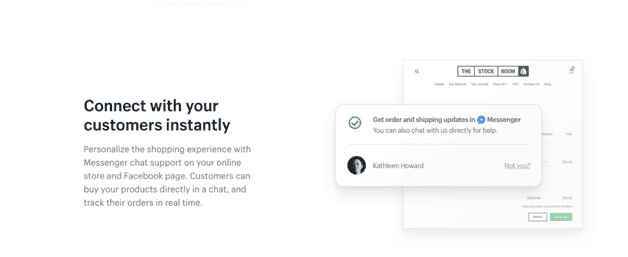
Partner with others businesses
Mutual partnership will help attract new customers. Entrepreneurs that come together can create special offers from an assortment of multiple stores, jointly host online events or organize a common point of sale.
This is especially useful when the capabilities of businesses complement each other. For example, a restaurant might sell readymade meals at a local supermarket, or a home decor business can partner up with a local florist to incentivize a customer with a bunch of flowers.
Sell digital goods and gift certificates
Adding digital products to the assortment will support the business. In addition, you don’t have to deal with the preparation and delivery of the order. You can sell:
- Ebooks, checklists, tutorials, and courses;
- Online lessons and consultations;
- Webinars and online workshops.
Gift certificates motivate people to make purchases and support your business. Make sure to use such incentives to make your assortment more versatile.·
Social media is your best friend
Use social media and mailing lists to communicate with clients and report changes in work. Always share updates on new products, opening hours, payment and delivery methods. Also, don’t forget to tell customers how they can support the store or what bonuses are available.
Don’t be shy to ask for donations. Loyal customers will be happy to support their favorite stores. Make it easy for them by adding a PayPal donation button to your site.
Add your store to online directories so that customers can see opening hours, address, reviews, and store photos. And be sure to update any information that has changed due to COVID-19.
Invest in your business
Growing business is a slow and steady process. Take your time to optimize your eCommerce to the shifting market conditions. Building a successful online business, determine which processes can be automated. These may include tasks that:
- must be handled manually on a regular basis;
- don’t require much of a human input;
- relate to data sharing between apps or departments;
- distract specialists from their primary responsibilities.
Automation will help if there is a shortage of staff and will bring dividends in the future. You can use apps like Salesforce, QuickBooks, and Google Drive for all-around business automation.
By investing in business during harsh market times, you position your store as successful and efficient, and this will have an effect when the situation stabilizes.
Content marketing is another efficient investment. You can create quality content on your own, according to your own schedule. You can send content pieces via newsletters and publish them on social networks. This comes in handy in the long run, especially in terms of SEO.
Bottom Line
Today is a perfectly good time to fundamentally rethink business strategies. You may have thought about how to launch an online store and whether it is worth doing at all before. Right now, however, there should be no doubt about it. Although there are no universal solutions, we hope our tips will help you. Stay profitable and demanded!

36 Kings Road
CM1 4HP Chelmsford
England


